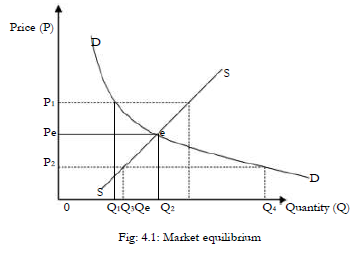Market Equilibrium is a state, in time, at which the price and quantity of a commodity are
purely determined by the interaction of the market forces of supply and demand such that there is no
tendency to change. At this point in the market the quantity supplied is equal to the quantity demanded of a commodity, such that there are no surpluses or shortages, and the wishes of suppliers and consumers coincide.At market equilibrium (market clearing point) the market price and quantity are known as the equilibrium price and quantity respectively.
Market equilibrium is either stable or unstable; a stable market equilibrium is where any slight divergence from the existing state generates economic forces (of supply and demand) which push both price and quantity towards it - the case of normal goods. An unstable market equilibrium is where any slight divergence from the existing state generates economic forces which push price and quantity even further away from it (i.e. away from the original state or position) - the case of inferior goods i.e. giffen goods whose relevant demand curve is positively sloped.
From the standpoint of a normal good, market equilibrium is diagrammatically demonstrated as follows:

Pe: Equilibrium (market) price
Qe: Equilibrium (market)
quantity e: Equilibrium point
SS: Supply curve
DD: Demand curve.
Wilfykil answered the question on
February 4, 2019 at 10:49